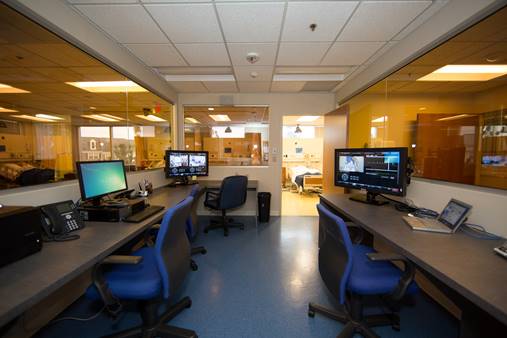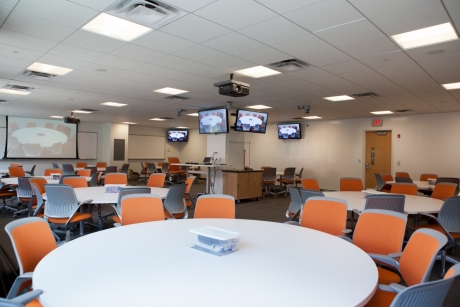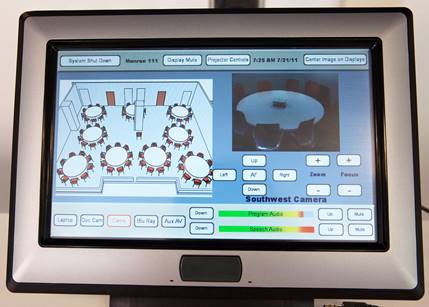Key Takeaways
- Experiential learning enhances student engagement and learning and thus is an important pedagogical driver of learning space design.
- Successful creation of experiential learning environments and faculty adoption and use of innovative learning spaces depend critically on collaborative partnerships.
- Investing in the creation of experiential learning spaces proves essential to preparing students for today's marketplace.
P.B. Garrett is associate provost and chief academic technology officer, Academic Technologies, The George Washington University.
Research shows that experiential learning enhances student engagement and success. For example, a meta-analysis of 225 previously published studies on the effects of active learning in science, technology, engineering, and math (STEM) courses revealed active learning's benefits.1 The analysis showed that students in traditional lecture sections are 1.5 times more likely to fail than students in active learning settings. Moreover, course grades were six percent higher when instructors used an active learning pedagogy. Students scoring in the 50th percentile in traditional lecture sections moved to the 68th percentile in active learning sections. Overall, the analysis projected that 3,516 fewer students would have failed STEM courses had instructors employed active learning approaches.
Implementing dynamic active learning pedagogies is best facilitated by fusing technology with classroom elements such as furnishings, lighting, and writing surfaces. Today's undergraduate students — and, increasingly, graduate students — comprise a cadre of learners whose education has involved a near-ubiquitous use of computers and networked devices. Laptops, tablets, and smart phones are commonplace tools for contemporary students. These tools are also a part of faculty life; thus, teaching practices and learning spaces (including virtual learning spaces) should not only accommodate current technologies but also be adaptable for those just over the horizon.
The George Washington University (GW) in Washington, D.C., is committed to creating experiential learning environments that benefit both students and faculty by addressing the needs for flexibility and meeting the pedagogical and learning demands of specific disciplines. In this article, I describe some existing and planned active learning spaces at GW and discuss key aspects of the development process.
Experiential Learning Spaces
After the university invested in providing network connectivity and low-technology capabilities to some of the classrooms in the early 2000s, discipline-specific needs began to arise. The expansion of classroom technology was initially conducted ad hoc, and designs were not unified across campus. Beginning in 2006, AV engineers at GW began to create design standards to unify classroom technology implementations. These design standards meet the unique needs of pedagogy while accommodating a variety of teaching styles and learning environments, including experiential spaces.
Nursing Skills and Simulation
A flagship of GW's active learning spaces is the award-winning, 6,300-square-foot School of Nursing's Skills and Simulation Lab, which was completed in 2012. The lab's environment lets nursing students synthesize didactic and clinical knowledge as they transition into professional practice. The opportunity to learn in a low-risk, experiential setting prepares them for employment by reducing anxieties related to working with real patients. As Patricia Davis, Skills and Simulation Lab director, said, "Best of all, I can see the 'ah-ha' in the students' eyes. It starts to come together for them and critical thinking pathways start to develop."
Key features of the School of Nursing's Skills and Simulation Lab
Patient simulation, via robotic mannequins, gives students repetitive skills practice within a variety of clinical reenactments, encouraging safe nursing care, teamwork, collaboration, and effective communication. Students and faculty alike benefit from the integration of technology, including embedded cameras, microphones, easy-to-operate large control panels, and video-teleconferencing capabilities for learning at a distance.
The lab features eight hospital beds, two private exam rooms, a mock studio apartment, a mock emergency room, and two control rooms (figure 1). The system can record three different scenarios at once, capture student reactions, and broadcast recordings to a 100-seat lecture hall and a 50-seat classroom.

Figure 1. The control rooms in the Skills and Simulation Lab support multiple
simulations.
The high-fidelity mannequins, ranging in age from infant to adult, have personal histories and lifelike features such as a pulse, simulated blood, a voice, and blinking eyes. One of the mannequins is even equipped to go into simulated labor and give birth. These "virtual patients" facilitate authentic patient–nurse interaction, giving students the opportunity to master bedside manner within a recreated hospital environment.
Brenda Gonzales, a student from the Loudoun County School of Practical Nursing, said of her experience in the lab, "I actually felt like I was at a hospital." Added nursing student Philipa Morse, "I think that the lab has been absolutely crucial to my learning. It's an amazing place to get the jitters out and most of all to practice, practice, practice."
Milken Institute Environments
The Milken Institute School of Public Health facility's key features
The classrooms in the recently constructed Milken Institute School of Public Health, a $75 million, 115,000-square-foot LEED Platinum-certified facility, provide another example of active learning environments. With the goal of promoting emerging pedagogies and evolving learning styles, the modular classrooms were designed for flexibility and varied active learning arrangements. Moving away from the traditional classroom, in which the instructor is "on stage," these classrooms feature modular furniture that is readily rearranged to create clusters of students for collaborative and interactive learning.
Julie DeLoia, the Milken Institute's associate dean for Academic Affairs, said of the spaces: "We wanted the flexibility to move students and technology around the room to catalyze collaborative learning and team projects."
Minimalist design melded with state-of-the-art technology — including large-scale display screens — offers an appealing asthetic and an effective environment for Millenial learners (figure 2).

Figure 2. The furniture in the Milken Institute School of Public Health's modular
classrooms is easily rearranged to foster interaction.
SCALE-UP Spaces
Participatory learning was also a major driver behind the design of GW's Physics, Astrophysics, and Engineering SCALE-UP spaces. Integrating lecture and lab elements, the Physics SCALE-UP classroom enhances learning using AMX technology, which lets instructors control four robotic cameras from a touch panel. Classwork can be presented from anywhere in the room and displayed via two projectors and six LCD displays.
The Engineering Lab has six hexagonal tables with built-in power and Internet adapters; the tables can be configured for group and lab work or organized into rows for lectures. Laptops and lab equipment, such as oscilloscopes, can plug directly into the AV system, which projects on three displays. In the Astrophysics Lab, the ceiling-mounted document camera also projects onto multiple displays, allowing instructors to engage students in group exercises and let them easily share instructive results (figure 3).

Figure 3. The Physics SCALE-UP space has a ceiling-mounted camera so that all
students can see and share classwork.
Collaborative Partnerships
Interdisciplinary partnerships are critical to the success of new learning spaces. Audiovisual engineers and IT staff members must understand the faculty's broad vision and specific objectives to make key decisions about how to design and incorporate technology into effective active learning classrooms. An ultimate goal of this process is to create environments that entice faculty to fully use powerful teaching tools to promote student engagement and learning.
In the School of Nursing project, for example, GW's nursing faculty worked closely with the Academic Technologies (AT) department in all stages of development to create a simulation lab that gave students a variety of clinical reenactments for hands-on learning. This dedicated collaboration created an academic innovation that leverages state-of-the-art technology to enrich the learning of nursing students.
At the onset of the design process, AT staff observed faculty and students in the original simulation lab and watched how the system functioned. Through subsequent meetings and reviews, AT designed an experiential learning space that both fulfilled the need for hands-on learning and made it easy for faculty to navigate the control room.
Jean Johnson, founding dean of the School of Nursing, was delighted with the results: "We have been ranked in the top 10 percent of nursing schools nationwide, which has everything to do with the quality of our education, and the quality of our undergraduate education has everything to do with the Simulation Lab," she said.
A collaborative process informs all of GW's experiential learning spaces. For example, a 2008 SCALE-UP project was guided by (and met) a Physics faculty member's vision and specific goals in creating seating arrangements for groups of students to work together. The instructor's intent was to teach students through their own problem solving; the classroom design and technology thus provided interactive student workspaces and allowed student work to be displayed from anywhere in the lab.
John Arpino, the AT assistant director of Research and Development, says of interdisciplinary alliances: "The question to ask isn't 'What do you want?' It's 'What are you trying to do?'"
This kind of questioning encourages finding ways to achieve both broad and detailed objectives. In addition, asking faculty members to describe their vision — rather than identify tools to accomplish it — creates broader opportunities for innovative solutions.
By designing and implementing these various projects, we've attained expertise and learned to pose the right questions, thereby developing best practices for creating optimal learning environments. With the knowledge we've gained through collaboration, we can efficiently clarify a new project's goals and create appropriate spaces and technology to meet them.
Lessons Learned
Knowledge gained from recently constructed active learning spaces is best exemplified by the School of Nursing project. The Nursing Skills and Simulation Lab was built on an existing lab that was created in 2009 and had many technological limitations. Because its technology was not seamlessly integrated, the earlier lab could not fully simulate a hospital environment. For example:
- Exposed cameras and microphones degraded the illusion of a real hospital setting.
- The use of two-way radios and lapel microphones for communication between students and simulated patients made "patient–nurse" interactions clumsy.
- No video technology was available, so students were unable to view their individual performances and thus were more likely to question instructor assessments.
To surmount these problems, learning space designers incorporated new audio technologies and developed custom-designed placements of devices, with microphones and cameras strategically placed at beds and within walls. As a result, the virtual setting looks and feels real. Students and faculty enter the clinical reenactment space without pretense. Video technology upgrades enable the recording of student performances, which lets faculty document students' improving skills and identify areas for further refinement. Live streaming also lets students watch their peers and participate at a distance.
After the implementation of the 2008 Physics SCALE-UP classroom, the design team discovered the importance of installing easy-to-use audiovisual equipment in order for the space to succeed. For example, instructors found it cumbersome to manually operate classroom video cameras when zooming in on objects. During a renovation of the space, audiovisual engineers implemented a unique solution that allowed instructors to automatically zoom in on an object simply by touching a 3D layout of the classroom on the touch panel (figure 4).

Figure 4. A 3D layout of the classroom displayed on the touch panel makes
it easy for instructors to operate classroom video equipment.
It is also vital to approach learning space design with both strategic and operational factors in mind. After the implementation of several design projects, audiovisual engineers began to realize the importance of involving IT support staff earlier in the project in order to best anticipate problems faculty members might encounter and their questions.
Building infrastructure that will support future additions and life-cycle upgrades is key to making the most of monies allocated to a particular project. To ensure longevity it is also important to consider refresh rates when identifying technology to use. Considering renovations and existing infrastructure additions at the onset reduces costs in all phases of further development and implementation. For example, even in 2012 School of Nursing faculty envisioned adding yet more lab space, so AT ensured that the new infrastructure would let designers incorporate ever-evolving technology. In fact, AT is currently meeting with nursing faculty to begin designs for an additional skills assessment lab, which is scheduled for completion in June 2015.
Because we anticipated post-launch feedback and requests for modifications from end users, we built resources into project plans accordingly. For example, nursing faculty requested changes to the control room user interfaces to facilitate better audio and video communication between instructors and students. Ultimately, these changes created a more intuitive control system. For every project, we allocate time and funding for these inevitable post-launch changes.
Other cost-saving measures include making sound decisions that serve students and faculty first and the "latest and greatest" technology second. It's easy to be seduced by new tools on the market. We carefully evaluate technology, including tools advocated for by individual faculty members, and select the technologies that meet learning goals in an effective and efficient manner.
Capitalizing on Investment
Although innovative learning spaces play a key role in optimizing student learning, expanding faculty use of those spaces beyond an initial advocate group can prove challenging. Faculty might be unfamiliar with specific technologies and may question their reliability. Absent previous positive experiences, faculty members might make negative assumptions that prevent them from readily adopting new tools that enhance the pedagogical environment.
At AT we use a variety of tactics to encourage and facilitate faculty members' use of active learning spaces and technology. We start by actively engaging faculty in the design process; this helps us develop lasting partnerships and create system interfaces that are as seamless as possible. We also offer targeted workshops that feature "visioning" of how new technologies can help faculty attain learning outcomes and create customized hands-on learning activities. In addition, we partner with leading faculty members who have embraced new technologies, asking them to demonstrate how they have successfully used them to facilitate learning. This has proven effective in increasing adoption rates among more reluctant faculty. Finally, we have found that giving faculty members new pilot devices to test within their classroom environments encourages adoption.
Technology should be reliable, like the air we breathe. Instructors should not have to worry that the systems will not work or feel intimidated by new teaching tools. To ensure a positive teaching experience, it is important that technology be available and fully functional at all times. AT incorporates advanced monitoring and remote assistant tools to ensure faculty members feel supported. When we design a learning space and install technology, we seek to create spaces and systems that will enhance, rather than disrupt, teaching and learning.
What Comes Next?
Projects currently in process at GW include the Science and Engineering Hall (figure 5), slated to open in 2015. By incorporating SCALE-UP spaces into learning environments for the $275 million, 500,000-square-foot structure, students and faculty will engage with teaching labs rather than classrooms. These sophisticated spaces support teaching and active learning as well as conducting research. Faculty from different fields in science and engineering will work in "research neighborhoods" designed to promote the interaction of people and interchange of ideas. With varied departments in one complex, these interdisciplinary environments encourage students to express their creativity and find new ways to process information.

Figure 5. GW's Science and Engineering Hall will feature teaching labs and
interdisciplinary "research neighborhoods."
Key features of the GW Science and Engineering Hall
Another project launching this fall is the first phase of a robust and cost-effective technological initiative that introduces new digital classroom standards to the university. These standards will let faculty present copyright-protected media, display high-quality video content, and wirelessly stream multimedia content from mobile devices. Students and faculty will be able to sync their mobile devices to present content in the classroom just like they synch an iPhone to play music in a car. We are also introducing consumer web conferencing tools that will let instructors teach from any location and invite guest lecturers into the classroom from around the corner or around the world.
As universities continue to embrace experiential learning, they must develop cost-effective learning spaces that address student and faculty needs. Vision must be met with strategic planning to address both learning goals and administrative imperatives (such as efficient operations and cost containment). Collaborative partnerships are also essential to success.
By continually anticipating technology advancements, higher learning institutions will be better poised to prepare their students for the new world. New learning spaces become proving grounds for innovative approaches to research, teaching, and learning, acting as templates for the real-world environments in which students will confront and meet humankind's challenges.
- Scott Freeman, Sarah L. Eddy, Miles McDonough, Michelle K. Smith, Nnadozie Okoroafor, Hannah Jordt, and Mary Pat Wenderoth, "Active Learning Increases Student Performance in Science, Engineering, and Mathematics," Proceedings National Academy of Sciences (PNAS), vol. 111, no. 23 (June 10, 2014).
© 2014 P.B. Garrett. The text of this EDUCAUSE Review online article is licensed under the Creative Commons Attribution-NonCommercial-NoDerivatives 4.0 license.
